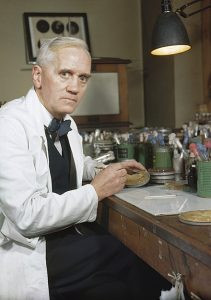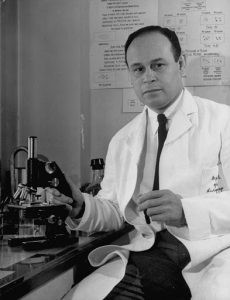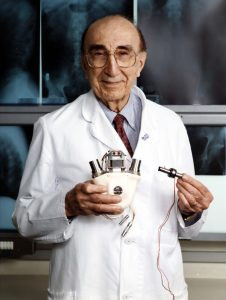In any society that values the well-being and prosperity of its people, healthcare stands as a cornerstone. The ability to prevent, treat, and manage illnesses directly impacts quality of life and fuels economic productivity. Therefore, medical practitioners hold an esteemed position, and throughout history, certain physicians have risen above, leaving an indelible mark on the field and humanity itself.
This article highlights ten of the most Famous Doctors whose relentless research, unwavering dedication, and groundbreaking innovations have fundamentally reshaped the landscape of medicine as we know it today. Their contributions have not only saved countless lives but have also paved the way for future generations of medical professionals to build upon their legacies.
1. Georges Mathé, MD: Pioneer of Leukemia Treatment and Bone Marrow Transplantation
Dr. Georges Mathé’s pioneering work in bone marrow transplantation and leukemia treatment revolutionized hematology and oncology. His early research focused on understanding the complexities of the immune system and its role in transplant rejection. Through meticulous preclinical studies, Dr. Mathé demonstrated that donor bone marrow cells could survive and proliferate in recipients only after their immune systems were suppressed through irradiation. This crucial finding laid the groundwork for successful bone marrow transplants.
In a dramatic real-world application of his research in 1958, Dr. Mathé treated Yugoslavian physicists who had suffered severe radiation exposure in a nuclear accident. By infusing them with donor bone marrow, he successfully saved all but one from the otherwise fatal consequences of radiation poisoning. Beyond this immediate life-saving intervention, Dr. Mathé achieved a landmark medical breakthrough by discovering a treatment for leukemia. He even successfully cured a patient through bone marrow transplantation, offering hope for those afflicted with this devastating disease. Furthermore, his insightful observations led to the definition of graft-versus-host disease, a critical complication in transplantation, which he correctly identified as an immune reaction from the donor marrow attacking the recipient’s cells.
 Sir Alexander Fleming
Sir Alexander Fleming
2. Sir Alexander Fleming, MD: The Accidental Discoverer of Penicillin
Sir Alexander Fleming’s name is synonymous with one of the most transformative discoveries in medical history: penicillin. Born in Scotland in 1881, Fleming’s early career was marked by a keen interest in the body’s natural defenses against bacteria. During his service as a captain in the Army Medical Corps during World War I, he witnessed firsthand the devastating impact of bacterial infections and the limitations of existing antiseptics. This experience fueled his pursuit of more effective antibacterial agents. Prior to his penicillin discovery, Fleming identified lysozyme, an antibacterial enzyme present in bodily fluids.
However, it was in 1928 that serendipity and keen observation converged to change medicine forever. While researching the influenza virus, Fleming noticed a mold contaminating a petri dish containing a staphylococcus culture. Instead of discarding it, his scientific curiosity led him to examine it further. He observed a clear, bacteria-free zone surrounding the mold, indicating its potent antibacterial properties. This mold was identified as Penicillium notatum, and Fleming’s meticulous investigation revealed that it could effectively inhibit the growth of various bacteria, including staphylococci. This accidental discovery of penicillin ushered in the antibiotic era, revolutionizing the treatment of bacterial infections and saving countless lives from diseases that were once considered death sentences.
 Helen Brooke Taussig
Helen Brooke Taussig
3. Helen Brooke Taussig, MD: The Mother of Pediatric Cardiology
Dr. Helen Brooke Taussig is rightfully recognized as the founder of pediatric cardiology, a field dedicated to the diagnosis and treatment of heart conditions in children. Her seminal work, “Congenital Malformations of the Heart,” published in 1947, became a cornerstone text for understanding and managing heart defects present at birth. Dr. Taussig’s most impactful contribution was the development of the Blalock-Thomas-Taussig shunt procedure. This groundbreaking surgical technique provided a lifeline for infants born with tetralogy of Fallot, a complex and often fatal congenital heart defect that restricts blood flow to the lungs. The shunt increased blood flow to the lungs, dramatically improving oxygenation and extending the lives of these children.
Beyond her surgical innovation, Dr. Taussig was a fierce advocate for patient safety and public health. She famously played a crucial role in banning thalidomide in the United States after recognizing its devastating link to birth defects in infants whose mothers had taken the drug during pregnancy. Her vigilance and determination protected countless children from these preventable deformities. Furthermore, she championed the combined use of X-rays and fluoroscopy to minimize invasiveness during cardiac and pulmonary examinations in children, enhancing diagnostic accuracy and patient comfort. Dr. Taussig’s pioneering spirit extended to professional leadership as well; she served as the first president of the prestigious American College of Cardiology, solidifying her position as a leading figure in medicine.
 Portrait of Dr. Charles Drew (1904 – 1950), Washington DC, 1946. Drew was a professor and Head of Surgery at Howard University, Chief of Surgery at Freedman
Portrait of Dr. Charles Drew (1904 – 1950), Washington DC, 1946. Drew was a professor and Head of Surgery at Howard University, Chief of Surgery at Freedman
4. Charles Richard Drew, MD: The Father of Blood Banking and Revolutionizing Blood Storage
Dr. Charles Richard Drew, an accomplished African American surgeon and medical researcher, is celebrated as the “father of blood banking” for his transformative contributions to blood storage and transfusion techniques. Driven by a deep interest in improving blood transfusion practices, Dr. Drew’s research focused on developing efficient methods for collecting, processing, and storing blood plasma. He ingeniously devised techniques that significantly extended the shelf life of blood, making it readily available for transfusion whenever and wherever needed. His innovations were instrumental in the design of large-scale blood banks, revolutionizing how blood was managed and distributed.
Recognizing the critical need for mobile blood collection during emergencies, Dr. Drew conceptualized and developed bloodmobiles. These specially equipped trucks, fitted with refrigerators for blood storage, served as mobile blood donation centers, enabling efficient blood collection and delivery to areas in need. Dr. Drew also streamlined blood collection procedures, establishing centralized donation centers that improved efficiency and donor accessibility. His pioneering work laid the foundation for the American Red Cross Blood Bank, an institution that continues to save lives daily by ensuring a safe and readily available blood supply. Despite facing racial discrimination throughout his career, Dr. Drew’s brilliance and unwavering commitment to medicine left an enduring legacy, transforming blood transfusion practices globally.
 Dr. Michael DeBakey holding an artificial heart.
Dr. Michael DeBakey holding an artificial heart.
5. Michael Ellis DeBakey, MD: A Giant in Cardiovascular Surgery and Innovation
Dr. Michael Ellis DeBakey stands as a towering figure in the history of cardiovascular surgery. His remarkable career spanned over seven decades, during which he performed more than 60,000 surgeries, including on presidents and celebrities, and lived to the age of 99. Born in 1908, Dr. DeBakey was a true pioneer, constantly pushing the boundaries of surgical possibilities and developing innovative solutions to complex cardiac problems. As one of the world’s first cardiovascular surgeons, his contributions are immeasurable.
Early in his career, in 1932, Dr. DeBakey developed a component that later became an integral part of the first heart-lung machine. This invention revolutionized open-heart surgery, allowing surgeons to operate on a still, bloodless heart. In the 1950s, he pioneered the use of plastic tubing in surgical procedures, significantly reducing the risk of stroke recurrence, kidney failure, and limb vascular compromise. Dr. DeBakey’s relentless pursuit of improvement led to the development of numerous groundbreaking procedures, including coronary artery bypass surgery and ventricular assist devices. He also achieved a historic milestone by implanting the first artificial heart pump to support patients with severe heart damage. His innovations have become standard practice in cardiovascular surgery, extending and improving the quality of life for millions worldwide.
6. Virginia Apgar, MD: Creator of the Apgar Score for Newborn Assessment
Dr. Virginia Apgar’s name is inextricably linked with the Apgar score, a simple yet profoundly impactful assessment tool used to evaluate the health of newborn babies immediately after birth. Developed in 1952, the Apgar score provides a standardized method for assessing a newborn’s transition from the womb to the outside world. Initially met with skepticism, the Apgar score is now universally adopted and has become an indispensable part of neonatal care. It quickly assesses five vital signs: heart rate, respiratory effort, muscle tone, reflex response, and color, providing a rapid indication of a newborn’s overall condition and need for immediate medical intervention.
Dr. Apgar’s contributions extended beyond the Apgar score. She made significant advancements in obstetrical anesthesia and investigated the correlation between infant Apgar scores and factors such as labor, delivery, and maternal anesthesia. She also collaborated with colleagues to develop new methods for measuring blood gases and serum anesthesia levels in newborns, further refining neonatal care. Breaking barriers in her own career, Dr. Apgar became the first woman to achieve full professorship at Columbia University College of Physicians and Surgeons in New York, paving the way for future generations of women in medicine and academia.
 CARE President and CEO Dr. Helene Gayle
CARE President and CEO Dr. Helene Gayle
7. Helene D. Gayle, MD: Leading Figure in HIV/AIDS Research and Global Public Health
Dr. Helene D. Gayle is a prominent physician, researcher, and global health leader renowned for her impactful work in HIV/AIDS research and public health. Early in her career, Dr. Gayle focused on the devastating effects of AIDS on children, adolescents, and families, recognizing the profound global implications of the HIV/AIDS pandemic. She began her career at the Centers for Disease Control and Prevention (CDC) as an epidemic intelligence service officer, gaining invaluable experience in disease surveillance and control.
Dr. Gayle’s career trajectory reflects a deep commitment to improving global health outcomes. She has held leadership positions in various organizations, including serving as President and CEO of CARE, a leading humanitarian organization. Her contributions to the study, control, and prevention of HIV/AIDS and tuberculosis have been substantial, influencing public health policy and interventions worldwide. Recognized for her influence and impact, Forbes magazine named her among the “100 Most Powerful Women.” Dr. Gayle’s distinguished career also includes service as Assistant Surgeon General and Rear Admiral in the Commissioned Corps of the US Public Health Service, further highlighting her dedication to public service and health.
 Edward Jenner
Edward Jenner
8. Edward Jenner, MD, FRS, FRCPE: The Father of Immunology and Smallpox Vaccination
Dr. Edward Jenner, an English physician, is revered as the “father of immunology” for his groundbreaking work in developing the world’s first vaccine – the smallpox vaccine. Born in 1749, Jenner lived in an era when smallpox was a global scourge, responsible for the deaths of an estimated 20% of the population. Inspired by the observation that milkmaids who contracted cowpox, a milder disease, seemed to be protected from smallpox, Jenner embarked on a scientific investigation that would change the course of medical history.
In a pivotal experiment, Jenner inoculated a young boy with matter taken from a cowpox pustule. The boy developed a mild illness but subsequently proved to be immune to smallpox. Jenner’s meticulous work demonstrated the principle of vaccination – using a weakened or related pathogen to induce immunity against a more dangerous disease. His discovery of the smallpox vaccine marked a monumental breakthrough in preventive medicine. Mass vaccination campaigns based on Jenner’s work eventually led to the global eradication of smallpox in 1979, a triumph of public health and a testament to the enduring impact of Jenner’s pioneering research. It is believed that Dr. Jenner’s work has saved more lives than that of any other human in history.
 Elizabeth Blackwell
Elizabeth Blackwell
9. Elizabeth Blackwell, MD: Breaking Barriers as the First Female Physician in the US
Dr. Elizabeth Blackwell holds a significant place in medical history as the first woman to earn a medical degree in the United States. Born in England in 1821, Blackwell faced immense societal barriers and discrimination in her pursuit of a medical career. Despite being repeatedly rejected by medical schools, she persevered and was eventually accepted by Geneva Medical College in New York. Throughout her medical education, she endured isolation and prejudice, often forced to sit separately in lectures and excluded from certain labs simply because of her gender.
Undeterred by these challenges, Dr. Blackwell graduated at the top of her class in 1849, shattering gender barriers and paving the way for women in medicine. She established her own clinic in New York City, focusing on providing care to underserved women. Driven by a desire to create opportunities for other women in medicine, she founded the New York Infirmary for Indigent Women and Children and later the Women’s Medical College of the New York Infirmary in 1868. Dr. Blackwell’s pioneering spirit and unwavering determination not only opened doors for women in medicine in the US but also inspired the establishment of the National Health Society in London, England, further extending her influence on healthcare globally.
10. Daniel Hale Williams, MD: Performing the First Successful Open-Heart Surgery
Dr. Daniel Hale Williams, an accomplished African American surgeon, achieved a historic milestone in surgical history by performing what is widely considered the first successful open-heart surgery in 1893. Born in 1856, Dr. Williams faced significant racial prejudice and hardship throughout his life and career. Despite these obstacles, he rose to become a highly skilled and innovative surgeon. In a groundbreaking procedure, Dr. Williams successfully repaired a stab wound to the pericardium, the sac surrounding the heart, without the benefit of modern surgical techniques or technology. This remarkable achievement demonstrated his exceptional surgical skill and courage.
Driven by a commitment to providing quality healthcare to all, regardless of race, Dr. Williams founded the Provident Hospital and Training School in Chicago in 1891. Provident Hospital was the first non-segregated hospital in the United States, providing care to both African American and white patients and offering training opportunities for African American nurses and doctors who were often excluded from other institutions. Provident Hospital, now known as Provident Hospital of Cook County, stands as a testament to Dr. Williams’ vision and dedication to equitable healthcare access. His pioneering open-heart surgery and commitment to social justice solidify his place as a truly famous and influential doctor.
In Conclusion
From time immemorial, the medical profession has been held in high regard, and rightly so. The famous doctors highlighted in this article represent just a fraction of the countless individuals who have dedicated their lives to advancing medical knowledge and improving human health. Their groundbreaking discoveries and unwavering commitment serve as an inspiration to aspiring medical professionals and a reminder of the profound impact that dedicated individuals can have on the world. As we move forward, their legacies continue to inspire innovation and progress in the ever-evolving field of medicine, promising a healthier future for all.
If you are inspired by these famous doctors and wish to contribute to the betterment of healthcare, consider pursuing a career in medicine. You can Study medicine in Malaysia, acquire a Bachelor of Medicine and Surgery degree or higher degrees and embark on your own journey of research, innovation, and service to humanity.
